There is never enough time in a day, especially when you're the King or
Queen. In order to help the Royal couple move quickly from one end of
their kingdom to the other, the local magicians have created magic
portals between two gates. The locals refer to these portals as
The Royal Gateways
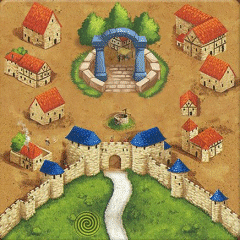
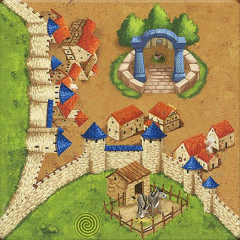
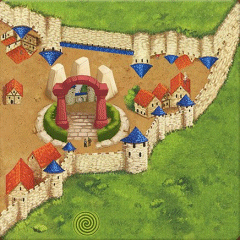
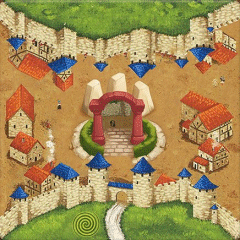
Our thanks to Snearone for the creation of this C2 version of the
fan-expansion.
The King and Queen of Carcassonne each control two Gateways that allow
them to secretly travel between two of their castles in the Carcassonne
cities.
The King's Gate with just 2 tiles was introduced by Korfmann and
JPutt927 in 2009. It was then upgraded to The Royal Gates, with
4 tiles in 2016. It is now being upgraded from C1 The Royal Gates
to C2 The Royal Gateways by Snearone as mentioned in the March 2, 2023
The Royal Gateways Carcassonne Central thread.
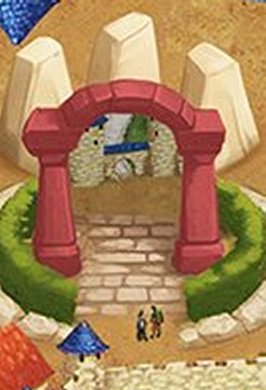
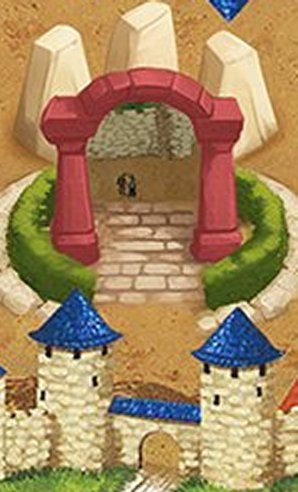
Before we get started on the rules, let's take a closer look at the
fantastic C2 images of the Queen's gateways created by Snearone.
Looking at the gateway on the left, we see two individuals standing in front
of and looking through the gateway at a city wall with two pillars connected by a small
city wall with a gate that leads to a white paved road.
Looking at the gateway on the right, we can see that city gate with the
external road is in front of the gateway, and you can see two individuals
standing inside the gateway with a solid wall behind them.
This clearly illustrates that each gateway is looking at, and is connected
to, the gateway in a different city!
The King's gateways are similiar, but the images that you are seeing through
the gateways are those of a well and a house with a tent in front of it.
Again, our thanks to Snearone for his efforts in the creation of these
extremely well designed C2 images.
The original downloadable PDF rules were posted
on 2/9/2013 for The King's Gate. The following rules are our logical
expansion those rules for two pairs of gates instead of just one pair of
gates.
King's Gate Rule: Both tiles are played with normal placement rules.
When the two King's Gate tiles are placed in different cities, the two are
considered to be the same city. If both tiles are played in the same
there is no effect.
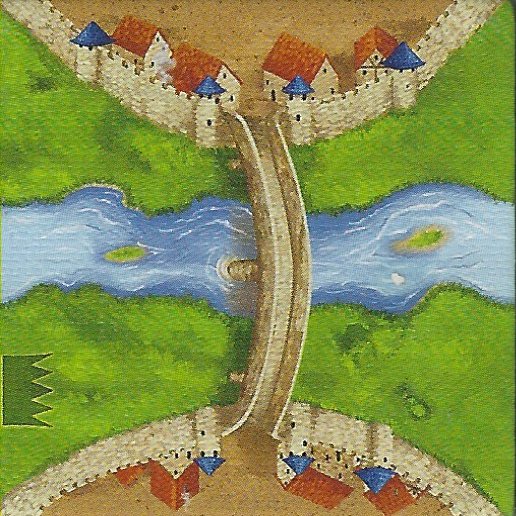
We are already used to playing with two separate cities, connected by a
bridge, separated by the river, but scored as if they are just one city.
The original King's Gate tiles performs the same action as the
bridge when each King Tile is placed in two different cities.
We could play with just one pair of Gateway Tiles to emulate the
original King's Gate expansion, or we could play with both pairs of
Gateway Tiles to make the game even more interesting. The rules for
each pair of gateways remain the same.
King's Gate Rule: Any player that places either one of these tiles
may deploy a follower to any part of the tile (city, road, or farm)
according to normal placement rules. A follower may not be deployed to the
portal itself. All followers placed in both cities containing the King's
Gate are counted together when determining who has the most knights in
the city.
Note: If a player places the second Gateway into an unoccupied city,
and the first Gateway is already in another occupied city, that player
cannot place his meeple on the city tile with the second Gateway because
it is too late, since the placement of that tile has already connected the
two cities, thus rendering both cities occupied!
King's Gate Rule: No scoring takes place until both cities
containing the King's Gate tiles are completed or at the end of the
game.
Final Scoring: When the two tiles containing the King's Gate are
placed in separate cities, both cities are treated and scored as if they
were the same city. All followers placed in each city are counted
together to calculate the majority. When either King's Gate tile is
placed in a city, that city is not complete until the city containing the
other tile is also complete. All tile features that effect scoring for
either city (cathedral tiles, siege tiles, etc) effect the total combined
score for both cities.
Note: If we are playing with all four Gateway Tiles; if City A
contains one Queen Tile and one King Tile, while City B contains the
second Queen Tile and City C contains the second King Tile: all three
cities would be scored as if they were just one city!
If we are playing Inns and Cathedrals, and one of the paired
cities has a Cathedral on it, all of the tiles and coats of arms in both
cities score 3 points, zero if incomplete at the end of the game.
If we are playing with Abbey and Mayor, the Mayor's strength will
include all of the coats of arms in both cities.
If we are playing with Traders and Builders, you collect your
Trader Tokens only when the combined cities are completed, and the
Builder Second Turn extend to of the cities.
Our standard game is usually played with 24 River Tiles plus 71 Basic
Game, 18 exp1 Inns, and 24 exp2 Trader Tiles. Plus, we sometimes add
16 Flying Machines, 20 Big Top, 6 Besieged, and / or 15 20th Anniversary
Tiles.
If we decided to play with one or two pairs of Gateway Tiles, it is
definitely possible that over 100 tiles could be placed on the map
between the first Gateway Tile and its second matching Gateway Tile.
For that reason, we are also including 4 “half bridges” that can be places
within any incomplete paired city as a reminder that that city is not to
be scored when its individual city walls are completed. All paired cities
have to be completed before the twin or triple city is scored!
And here is some of the Carcassonne Central chatter about the rules:
This expansion was first introduced by CKorfmann and jputt927 as The
King's Gate, around 2016, and this is one of the first threads about
The Royal Gates, which added a second pair of Queen's Gates.
In this thread stalcupojoy asked these questions:
Q1. King's and Queen's Gate in the same city: If City A (King's
Gate) is considered part of City B (King's Gate and Queen's Gate), and
City B is considered part of City C (Queen's Gate), is City A considered
part of City C? In other words: are all three cities considered one big
city (under blue's control)? Or, as my wife argued, would these three cities
function as two separate incomplete cities, a 9-point "King's Gate" city for
blue and a 10-point "Queen's Gate" city shared by blue and plain-wood (which
means City B gets counted twice)?
Q2. Farm scoring: Since the city with both Royal Gates didn't
complete, does my (blue) farmer's farm have four complete cities or just
two?
Q3. Meeple placement: If a player places the second King's Gate into
an unoccupied city, and the first King's Gate is already in another occupied,
can that player place his meeple on the city tile with the second King's Gate
(kind of like the battles for control in The Labyrinth)? Or is it too late,
since the placement of that tile has already connected the two cities, thus
rendering both cities occupied?
Which were originally answered by ny1050220 this way.
Q1: I would prefer considering them one big city.
Q2: Two completed cities. Even if the King's and the Queen's gates are not
in the same city, you wouldn't consider the the seemingly completed cities
controlled by blue or wooden really completed because of the presence of
royal gates in their respective city sections.
Q3: I think it's too late. My understanding it that once the two gates are
both present, both city sections containing the gates are one big city. An
inappropriate example is Alaska and the lower 48 states.
An alternative solution to Q1 and Q2 is not to permit placing two gates in
the same city.
Then responded to by CKorfmann this way.
As to your first two questions. I never considered that issue since I was
only working with one pair at a time. In fact, I'd consider making it a rule
that the two gates can not occupy the same city to avoid complicated scenarios
like this one. I'd probably default to two complete cities on the second
question.
As for your third question, it is too late. Once the tile is placed, the cities
are connected.
I hope that helps. It's nice to see it in play by other people.
A few comments.
1. Place a tile. Comment: "When the two King's Gate tiles are placed in
different cities, both cities are considered to be as one." Statement
unclear what one thing both cities are considered to be. I think you
mean "considered to be the same city".
2. Deploying a Follower. Comment: "All followers placed in both cities c
ontaining the King's Gate are counted together when calculating the
majority." The proper phrase is "determining who has the most knights
in the city" instead of "calculating the majority".
3. Score. Comment: "No scoring takes place until both cities containing
the King's Gate tiles are finished or the game comes to an end." That
sounds omnimous! "finished" is vague as the rules normally uses
"completed". "the game comes to an end" would be better phrased (and is
usually done so in the rules) as "the end of the game".
Rev it up to 1.0 after that and PDF it and I'll upload it to Public
Downloads.
|